Antoine de Logiriera
Archaic Spanish-suited playing cards published in Toulouse by Antoine de Logiriera (1495-1518).
In the fifteenth century Spanish-suited playing cards were utilized in France, primarily in the southern regions of the country with historical connections to Spain. These archaic playing cards were a combination of at least two different decks. One deck featured knaves, cavaliers, and kings (without queens), while the other deck included what appeared to be a female ace of coins. The four of coins displayed a monogram "AL" in an escutcheon, and the maker's full name appeared on the pages of swords and cups.
It's important to note that these cards were not intended for export to Spain. The coins suit depicted the coats of arms of French cities. For instance, the 3 of coins showcased the arms of Thiers at the top, the Parisian galley at the bottom, and the banner of the Spanish province of Aragon in the middle. The 5 of coins depicted the abbey of Saint-Sernin de Toulouse. Similarly, the four of cups featured the arms of Lyon. Additionally, the two of cups displayed a cow, which potentially linked it to the game of Aluette. The legends on the cards were written in a mixture of French ("Tel se rit qui mord," "Coeur de femme trompe le monde," "De tous te fie et te garde") and Occitan ("Qui mal bet[e] foot the juego"). Occitan is a Romance language primarily spoken in southern France, parts of Italy, Spain, and Andorra. It is also known as "Provençal" in certain areas.
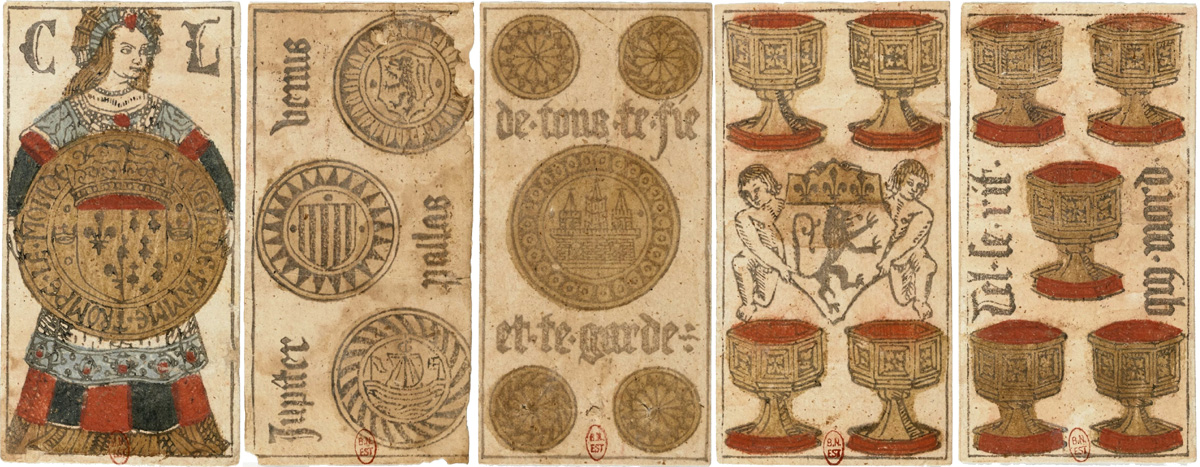

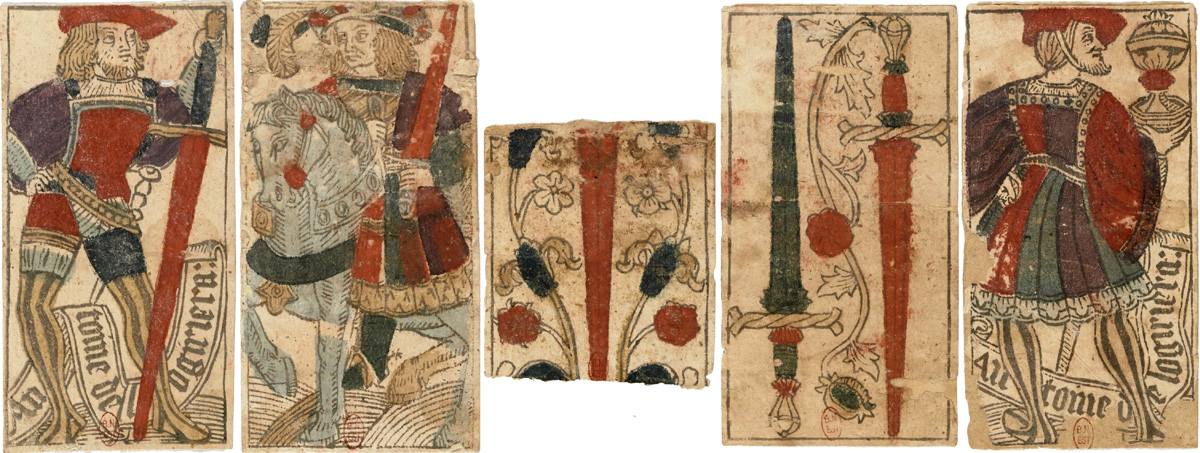


Above: Spanish-suited playing cards from several different packs published in Toulouse by Antoine de Logiriera (1495-1518). Source gallica.bnf.fr / Bibliothèque nationale de France • Jeu de cartes à enseignes espagnoles - Antoine de Logiriera►
Trom 1234 to 1512, Navarra had various dynastic connections to the kingdom of France. The legend on the ace of coins, which depicted a medallion containing the arms of Navarre and fleurs de lys, topped by an eagle, the seal of the King of Navarre, referred to King Juan II, who reigned from 1425 to 1479. The subsequent years are unclear due to civil wars and conflicting accounts. the legend "Coeur de femme trompe le monde," and the initials 'C.L.'
In 1512 the kingdom of Navarre was invaded by Ferdinand the Catholic, and integrated into the Kingdom of Spain.
By Simon Wintle
Spain • Member since February 01, 1996 • Contact
I am the founder of The World of Playing Cards (est. 1996), a website dedicated to the history, artistry and cultural significance of playing cards and tarot. Over the years I have researched various areas of the subject, acquired and traded collections and contributed as a committee member of the IPCS and graphics editor of The Playing-Card journal. Having lived in Chile, England, Wales, and now Spain, these experiences have shaped my work and passion for playing cards. Amongst my achievements is producing a limited-edition replica of a 17th-century English pack using woodblocks and stencils—a labour of love. Today, the World of Playing Cards is a global collaborative project, with my son Adam serving as the technical driving force behind its development. His innovative efforts have helped shape the site into the thriving hub it is today. You are warmly invited to become a contributor and share your enthusiasm.

Leave a Reply
Your Name
Just nowRelated Articles
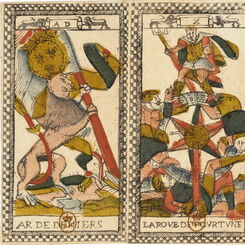
The Parisian Tarot
The “Parisian Tarot”, early 1600s, with imagery and design synthesizing several influences.
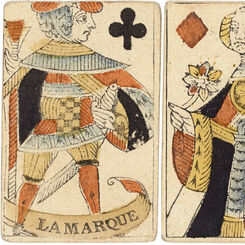
Languedoc pattern - Portrait de Languedoc
The old Languedoc pattern was known at the beginning of the seventeenth century, if not before.

Pierre Roiné Aluette
Archaic form of Aluette published by Pierre Roiné, Nantes, c.1785.
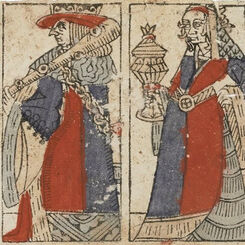
J. Deluy c.1490s
Archaic Spanish-suited cards produced by J. Deluy c.1490s.
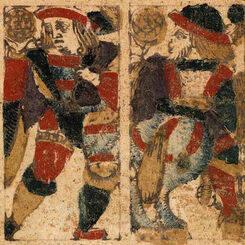
Toledo, 1584
Archaic Spanish-suited deck with 48 cards made in Toledo in 1584.
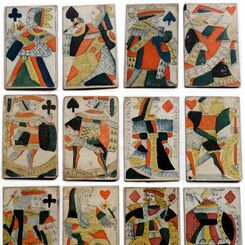
Provence Pattern - Portrait de Provence
The 'Provence' pattern contains figures which go back to the fifteenth century.

Malta
The so-called ‘Dragon Cards’, with winged monsters on the four Aces, are an enigmatic aspect of earl...
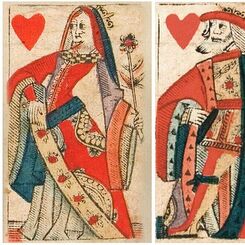
Pierre Marechal
Rouen became an important centre for card-making whose influence extended far afield. Cards from Rou...

Benoist Laius
Spanish playing cards such as these were used in those parts of France where certain games were enjo...

Giuseppe Cattino
Playing cards manufactured in Italy by Giuseppe Cattino and Paolo Montanar for Spanish markets.
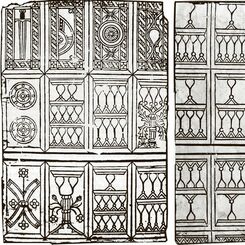
Moorish playing cards
These two uncoloured, uncut sheets of early Moorish playing cards were formerly preserved in the Ins...

Gothic Spanish-suited cards
These cards may be a typical example of early 'standard' Spanish playing cards, maybe from before Co...

Paris Pattern
The Paris pattern was established as such around the middle of the seventeenth century (based, perha...

French Playing Cards
Some of the oldest cards still in existence come from France. During the 16th and 17th centuries Fra...

Early Anglo-French Cards
Cards produced in Rouen during the sixteenth century. It was cards like these which were imported to...

History of Court Cards
The court cards in English packs of playing cards derive from models produced by Pierre Marechal in ...

Baraja Morisca — Early XV century playing cards
Primitive Latin suited pack, dated by paper analysis as early XV century, which makes this one of th...
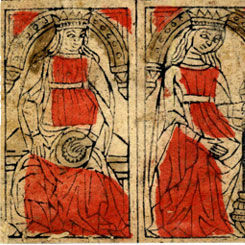
XV Century Italian Playing Cards
Cards from a pack of an early form of north Italian playing cards, with the swords back-to-back and ...

Grimaud Spanish pattern
Grimaud Spanish pattern, c.1880
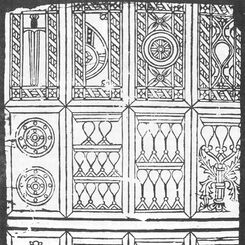
A Moorish Sheet of Playing Cards
This article was originally published in “The Playing-Card”, the Journal of the International Playin...
Most Popular
Our top articles from the past 60 days


 Your comment here. Your comment here. Your comment here. Your comment here. Your comment here. Your comment here. Your comment here. Your comment here. Your comment here. Your comment here. Your comment here. Your comment here. Your comment here. Your comment here. Your comment here. Your comment here. Your comment here. Your comment here. Your comment here. Your comment here. Your comment here. Your comment here. Your comment here. Your comment here. Your comment here. Your comment here. Your comment here. Your comment here. Your comment here. Your comment here. Your comment here. Your comment here.
Your comment here. Your comment here. Your comment here. Your comment here. Your comment here. Your comment here. Your comment here. Your comment here. Your comment here. Your comment here. Your comment here. Your comment here. Your comment here. Your comment here. Your comment here. Your comment here. Your comment here. Your comment here. Your comment here. Your comment here. Your comment here. Your comment here. Your comment here. Your comment here. Your comment here. Your comment here. Your comment here. Your comment here. Your comment here. Your comment here. Your comment here. Your comment here.




















